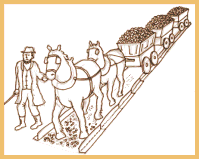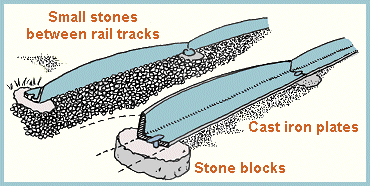In such a hilly district it was not possible to build the line without gradients, but the route was made as level as the land allowed.

| Carrying coals to Hay and beyond |
| The simple
idea that made the Hay Tramroad (and similar lines
elsewhere) work was that horses could pull much
heavier loads without difficulty if they were harnessed to wagons
that ran on smooth metal tracks, rather
than on uneven or muddy roadways. In such a hilly district it was not possible to build the line without gradients, but the route was made as level as the land allowed. |
 |
|
Iron rails
The
stone |
 |
|
|
| The flat wagon wheels (shown below) were kept in line by the vertical sides of the plates. Small stones between the rails provided grip for the horses pulling the loaded wagons. |
|
Cast
iron
tram wheel |
 |
The wheels
on the wagons or trams were made of cast iron, and different patterns were
used. Some companies using the line had their initials or other designs
cast onto their tram wheels. On modern railways the wheels are kept on the tracks by vertical flanges on the train wheels themselves, rather than by the vertical sides of the rails, as used on the old tramroads. |
|
The first section of the tramroad
between Brecon and Hay was built between
1811 and 1816,
and it was over 22 miles long. Although the line was built before Victoria
became Queen in 1837, it was in use for much of the Victorian age until
steam trains took over in the 1860s.
|
||
|
RDR
|